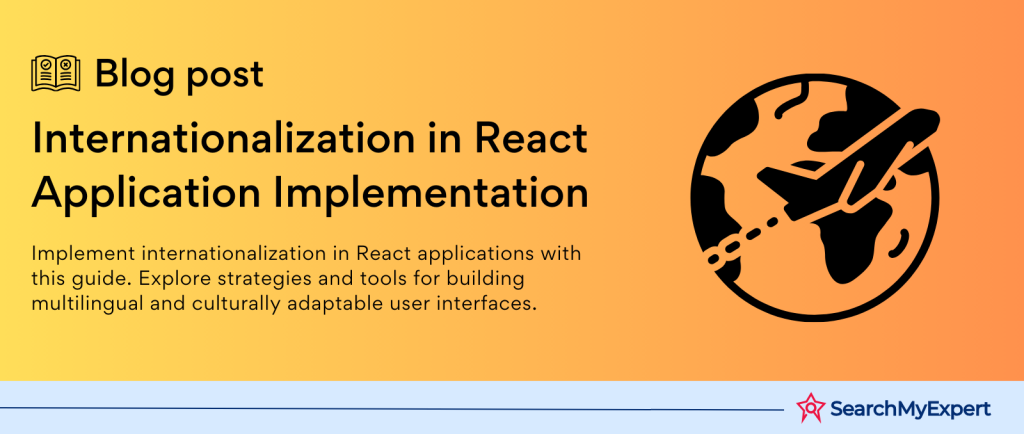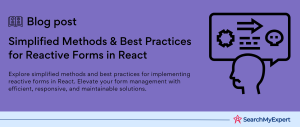Internationalization (i18n) in React
In today’s digitally connected world, creating applications that can reach a global audience is more crucial than ever. Internationalization, often abbreviated as i18n (where “18” stands for the number of letters between “i” and “n” in the word “internationalization”), plays a pivotal role in this endeavor. This concept is particularly significant in the realm of React development, where building globally accessible apps can significantly broaden a product’s reach and user engagement.
What is Internationalization (i18n)?
Internationalization is the process of designing and preparing your application to be usable in different languages and regions. It’s not just about translating text; it involves handling plural forms, date and time formatting, left-to-right and right-to-left text direction, and more. For React developers, this means creating applications that can easily adapt to various languages and cultural norms without requiring significant changes to the codebase for each new language or locale.
Importance of i18n in React Development
The importance of i18n in creating globally accessible React apps cannot be overstated. By integrating internationalization principles, developers can:
- Reach a Wider Audience:
Tailoring your app to support multiple languages makes it accessible to millions of more users worldwide. - Improve User Experience:
Users are more likely to engage with an application that speaks their language and respects their cultural norms. - Increase Market Penetration: Entering new markets becomes significantly easier when your app can easily adapt to local languages and customs.
- Enhance Brand Image: Demonstrating cultural sensitivity and inclusivity can positively impact your brand’s perception.
Challenges of i18n in React Development
While the benefits are clear, incorporating i18n into React applications comes with its set of challenges:
- Complexity in Implementation: Managing multiple languages can complicate the development process, from handling translations to ensuring layout compatibility across languages.
- Dynamic Content Translation:
Translating dynamic content that comes from users or external sources adds another layer of complexity. - Performance Considerations:
Loading and switching between languages can impact app performance, requiring careful management of resources. - Continuous Maintenance:
As the app evolves, keeping translations up to date and adding support for new languages can demand ongoing effort.
Benefits of i18n in React Development
Despite these challenges, the benefits of implementing i18n in React apps are undeniable:
- Enhanced Accessibility:
Making your app accessible in multiple languages breaks down barriers for users from different linguistic backgrounds. - Improved SEO:
Multilingual websites have a better chance of ranking high in search engines in various countries. - Competitive Advantage:
Offering a multilingual app can set you apart from competitors who do not cater to a global audience. - Increased Engagement and Conversion Rates:
Users are more likely to convert and engage with content presented in their native language.
Key Concepts and Terminology in React Internationalization
To effectively implement internationalization (i18n) in React applications, understanding the fundamental concepts and terminology is crucial. This knowledge not only simplifies the development process but also ensures that your application can seamlessly adapt to different languages and regions. Below, we’ll explore essential i18n concepts such as locale, translation files, and message formatting, and introduce some of the most popular i18n libraries in the React ecosystem.
Locale
A locale represents a combination of language and region (usually a country) that defines the user’s language, regional settings (like date, time, and number formats), and text direction. For example, en-US stands for English language as used in the United States, while fr-CA represents French as used in Canada. Handling locales correctly is the first step in ensuring that your React app can be internationalized effectively.
Translation Files
Translation files are resources that store the translations of your application’s text content. These files are typically organized by locale, with each file containing key-value pairs; the keys remain consistent across locales, while the values contain the translated text. JSON is a common format for these files, thanks to its simplicity and ease of use in JavaScript projects. Managing translation files efficiently is crucial for maintaining the scalability and manageability of your app’s internationalization features.
Message Formatting
Message formatting involves dynamically inserting content into translations and formatting data (like numbers, dates, and times) according to the user’s locale. This process is more complex than simple text replacement, as it must account for pluralization rules, gender, locale-specific formats, and other linguistic nuances. Proper message formatting ensures that your app not only speaks the user’s language but also respects their cultural norms and expectations.
Common i18n Libraries for React
Several libraries are available to simplify the process of internationalizing React applications. Here are some of the most commonly used:
react-intl
- Part of the FormatJS suite, react-intl provides React components and an API to format dates, numbers, and strings, including pluralization and handling right-to-left languages.
- It uses a declarative approach to define messages inside components, making it intuitive for React developers.
react-i18next
- Building on the popular i18next library, react-i18next offers extensive support for translations, including handling of plurals, context, interpolation, and formatting.
- It supports hooks, higher-order components (HOCs), and components, providing flexibility in how you can integrate internationalization into your React app.
i18next
- While not specific to React, i18next is a powerful internationalization framework that can be used with React through react-i18next.
- It offers a rich ecosystem with plugins for detecting the user’s language, loading translations, and even integrating with backend services or filesystems.
Comparing Library Options
When comparing these libraries, consider factors like ease of integration, community support, flexibility, and feature set. For instance:
- react-intl is a great choice if you prefer a standards-based approach, leveraging the built-in JavaScript Intl API.
- react-i18next and i18next shine in terms of flexibility and the breadth of features, including backend integration and language detection.
- Choose based on your project’s specific needs, the complexity of your internationalization requirements, and your team’s familiarity with these libraries.
Setting Up Your i18n Environment in React
Creating a multilingual React application involves selecting and setting up an internationalization library that suits your project’s needs. This step is crucial for ensuring that your app can support multiple languages and adapt to various locales seamlessly. In this guide, we’ll walk through the process of installing and configuring an i18n library in your React project, focusing on the essential steps required to support multiple languages, set a default locale, and implement fallback mechanisms. We’ll also touch on integrating your i18n setup with build tools and deployment strategies.
Installation and Basic Configuration
Once you’ve selected an i18n library, the next step is to install it in your React project. Installation is typically done via npm or yarn. For example, if you’re using react-i18next, you would run a command like npm install react-i18next i18next –save or yarn add react-i18next i18next.
After installing the library, you’ll need to configure it. This involves:
- Specifying Supported Languages:
Define the languages your application will support. This usually means creating a directory for your translation files and organizing them by language code (e.g., en, fr, de). - Setting a Default Locale:
Choose a default language for your application. This language will be used when the user’s preferred language isn’t available. - Implementing Fallback Mechanisms: Configure fallback options to ensure that your app can gracefully handle missing translations or unsupported languages. Most libraries allow you to specify a fallback language or even provide default text directly in your code.
Loading Translation Files
Your i18n library will need to load translation files that contain the localized strings for each supported language. This typically involves setting up a way to import or fetch these files based on the user’s current locale. Some libraries offer the option to load these resources from local files, a server, or a content delivery network (CDN), providing flexibility in how you manage and distribute your translations.
Integrating with Build Tools
Integrating your i18n setup with build tools like Webpack or Create React App can streamline the process of managing translations and locales. For instance, you might use plugins or loaders to automatically compile your translation files during the build process. This integration can also help with optimizing the loading of language resources, ensuring that users download only the translations relevant to their selected language.
Defining and Managing Your Translations
When internationalizing a React application, the way you define, structure, and manage your translations is pivotal for accommodating diverse languages and cultures effectively. Understanding the various formats for translation files and adhering to best practices can significantly streamline this process. Let’s delve into the nuances of different translation file formats, their advantages and disadvantages, and explore strategies for efficiently organizing and managing these files.
Translation File Formats
Translation files are the backbone of any internationalized application, containing all the text strings in various languages. The choice of format for these files can impact both the development process and the ease of translation management. The most common formats include JSON, YAML, and XLIFF, each with its unique set of characteristics.
JSON (JavaScript Object Notation)
- Pros:
JSON’s syntax is both human-readable and machine-parseable, making it a natural fit for web applications, especially those built with JavaScript frameworks like React. Its lightweight nature facilitates fast loading and processing. - Cons:
The lack of support for comments in JSON can be a drawback for providing context or notes directly within the translation files.
YAML (YAML Ain’t Markup Language)
- Pros:
YAML is highly readable and allows for comments, offering a more convenient way to include notes and context for translators. Its structure is intuitive, making it easier to organize complex translations. - Cons:
YAML files can be more prone to syntax errors due to their reliance on indentation. Additionally, they may require conversion into JSON or another format for use in the application, adding a step to the build process.
XLIFF (XML Localization Interchange File Format)
- Pros: XLIFF is designed specifically for translation and localization, supporting a wide range of features such as plural forms, context, and metadata about translations. It is a standard format in the translation industry, facilitating collaboration with professional translators.
- Cons:
The verbose nature of XML makes XLIFF files bulkier and potentially more challenging to work with directly for developers not familiar with XML. It also often requires specific tools or libraries for processing.
Creating and Structuring Translation Files
Effective translation file management starts with thoughtful organization. Structuring your files in a way that reflects the architecture of your application can simplify both development and translation processes.
- Organize by Locale:
Create a directory for each supported language, using language codes as directory names (e.g., en, fr, es). This approach makes it easy to locate and manage translations for each locale. - Modularize Translations:
Consider breaking down translations into smaller files based on application features, screens, or components. This modular approach can reduce complexity and make it easier to update translations related to specific parts of your app.
Best Practices for Translation Management
To ensure your translation efforts are effective and sustainable, consider the following best practices:
- Descriptive Keys:
Use keys that accurately describe the content or purpose of the text. This clarity can significantly aid translators and developers alike. - Pluralization and Context:
Different languages have varied rules for pluralization and may require different translations based on context. Leverage the features of your i18n library to handle these nuances properly. - Dynamic Content:
For translations that need to incorporate dynamic content (e.g., user names, dates), ensure your translation strings are designed to include variables or placeholders that can be replaced at runtime. - Continuous Localization:
As your application evolves, so too will your translation needs. Establish a process for regularly updating and adding translations, ideally integrating this process into your development workflow.
Implementing i18n in React Components
Integrating internationalization into your React components involves more than just translating static text; it encompasses the localization of dates, numbers, handling dynamic content, and even conditionally displaying content based on the user’s locale or preferences. This step explores practical techniques for effectively using your chosen i18n library to achieve these goals, ensuring your React application delivers a truly global user experience.
Translating Text in Components
The core functionality of any i18n library in a React application is to translate text. This typically involves wrapping your static text in a translation function or component provided by your i18n library. These functions or components take a key that corresponds to entries in your translation files and render the text in the user’s current language.
Localizing Dates and Numbers
Dates and numbers often need to be formatted differently depending on the user’s locale. For example, the date format varies widely across regions, as does the use of commas or periods in decimal numbers. Many i18n libraries offer utilities to handle these localizations seamlessly, automatically adjusting the format based on the current locale. Incorporating these functionalities ensures that your application respects the local conventions of your users, enhancing the overall user experience.
Handling Dynamic Content Interpolation and Formatting
Dynamic content, such as user-generated text, variables, or data fetched from an API, presents unique challenges in internationalized applications. Interpolation features of i18n libraries allow you to insert dynamic content into your translations. This is often done through a templating syntax within the translation string, where placeholders are replaced by actual values at runtime. Properly handling dynamic content ensures that your application remains flexible and user-friendly across different languages.
Conditionally Displaying Content Based on Locale
There may be instances where certain content or features should only be available to users in specific locales. To achieve this, your application can conditionally render components based on the current locale or user preferences. This technique involves using the locale detection features of your i18n library to determine the user’s locale and then rendering content accordingly. This can be particularly useful for region-specific content, features, or even compliance with local regulations.
Formatting and Localization Considerations
In the realm of internationalization, the ability to present data in a culturally appropriate format is as crucial as translating the application’s text. This approach not only enhances usability but also shows respect for the user’s cultural norms. This step delves into the nuances of formatting dates, numbers, currencies, and more, while also addressing the challenges posed by right-to-left (RTL) languages and other layout concerns. By adhering to best practices in these areas, developers can ensure their React applications resonate with a truly global audience.
Culturally Appropriate Formatting
Dates, Numbers, and Currencies
The way dates, numbers, and currencies are formatted can vary significantly from one culture to another. For instance, while the United States uses the month/day/year format for dates, many countries prefer day/month/year or year/month/day. Similarly, the use of commas and periods in numbers can differ; some locales use a comma as a decimal separator, whereas others use a period. Currencies not only need to be converted based on the current exchange rate but also formatted according to local conventions, including the placement of the currency symbol.
To address these variations, utilize the internationalization APIs or the formatting utilities provided by your i18n library to automatically adjust the format based on the user’s locale. This ensures that your application displays information in a way that is familiar and intuitive to the user.
Handling Right-to-Left (RTL) Languages
Languages such as Arabic, Hebrew, and Persian are written from right to left, presenting unique challenges for layout and design. Support for RTL languages goes beyond simply translating text; it requires careful consideration of the entire application’s layout. This might involve flipping the direction of text, images, icons, and even the UI’s navigational elements.
Many modern CSS frameworks and React component libraries offer built-in support for RTL layouts, automatically adjusting styles based on the directionality of the current language. Additionally, the dir attribute in HTML can be dynamically set to rtl for RTL languages, enabling browsers to apply the correct text alignment and flow.
Time Zones and Number Systems
Global applications must also navigate the complexities of time zones and different number systems. Displaying dates and times in the user’s local time zone is crucial for applications that deal with scheduling, deadlines, or live events. JavaScript’s Date object and various libraries can help convert times to local zones automatically.
Number systems, such as Arabic or Hindi numerals, may also differ across cultures. When localizing numbers, consider not only the format but also the numeral system used by the locale. Some i18n libraries and the JavaScript Intl API provide support for these considerations, ensuring numbers are displayed in the most appropriate format for the user’s locale.
Testing and Debugging i18n in React Applications
Ensuring that your React application behaves as expected across different locales is critical to the success of your internationalization efforts. This step covers strategies for testing translated text and component behavior in various locales, tools and techniques for troubleshooting i18n issues, and considerations for integrating internationalization into your continuous integration and deployment (CI/CD) pipelines.
Strategies for Testing Translated Text and Component Behavior
Manual Testing
- Locale Switching:
Manually switch between different locales in your application to verify that texts are correctly translated and formatted according to each locale’s rules. Pay attention to layout changes, especially for right-to-left (RTL) languages. - Cultural Sensitivity: Beyond just the language, ensure that images, icons, and color schemes are appropriate and respectful of cultural norms.
Automated Testing
- Unit Tests:
Write unit tests for your components using various locale settings to ensure that translations and locale-specific formats (dates, numbers, etc.) are correctly applied. - Integration and End-to-End Tests:
Utilize tools like Selenium or Cypress to automate testing of the UI and workflows in different locales. This can help catch issues that unit tests might miss, such as dynamic content loading and interaction flows.
Tools and Techniques for Troubleshooting i18n Issues
i18n Linting and Quality Checks
- Utilize linting tools designed for i18n to catch common issues such as missing translations, unused keys, or formatting errors in your translation files.
Logging and Monitoring
- Implement logging for i18n-related errors or warnings. Monitoring tools can alert you to issues encountered by users in production, such as failed translation loading or fallbacks being triggered more often than expected.
Localization Management Platforms
- Platforms like Transifex, Crowdin, or Lokalise offer translation management tools that can help streamline the translation process, provide quality checks, and facilitate collaboration with translators. They also offer features for previewing translations in context, which can be invaluable for spotting and correcting issues.
Continuous Integration and Deployment Considerations
Automated Tests in CI Pipelines
- Integrate your automated tests into your CI pipeline to catch i18n issues early in the development process. Ensure that tests cover a range of locales, especially those that are critical to your application.
Translation Workflow Integration
- Automate the synchronization of translation files between your source code repository and any external translation management platforms you’re using. This can help ensure that translations are always up-to-date and reduce manual handling.
Conclusion
Internationalization is a crucial aspect of modern web development, enabling applications to reach a wider, global audience. Through this comprehensive guide, we’ve explored the key steps to successfully implement i18n in React applications—from setting up the i18n environment and managing translations to localizing dates, numbers, and handling right-to-left languages. We’ve also covered the importance of culturally appropriate formatting, strategies for testing and debugging i18n issues, and considerations for continuous integration and deployment.
Effective internationalization goes beyond mere translation. It involves a deep understanding of cultural nuances, technical strategies for localizing content, and a commitment to inclusivity. By following the best practices outlined in this guide, developers can ensure their React applications resonate with users across different cultures and regions, providing a truly global and accessible user experience.
Let our React Development Service Company be your partner in frontend excellence.
Table of Contents
Toggle






